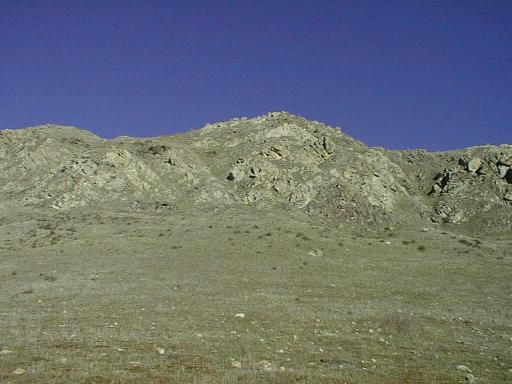Up: Mission Peak main page Previous Story of the McClure Ranch
![]()
![]()
![]()
Up: Mission Peak
main page Previous Story of the McClure
Ranch
by Dennis Rockstroh, SJ Mercury News staff writer
Published: Friday August 14, 1992

View of Summit from McClure Ranch area. This cliff is where the goats live. Two white goats are indicated by black caret symbols (^) in a larger image (92K) taken 12/16/2000.
Listen to Roan McClure talk about the Mission Peak goats (3.3 MB, 2:59).
Fremont's highest residence, at about 2,000 feet above sea level, is so high that its nearest neighbors are goats on the craggy face of Mission Peak.
Reader Alison Chaiken wondered about this place and penned this letter:
Dear Dennis,
Now that you have explained why the salt evaporators turn
color and and how Warm Springs got its name, can you find out
about the goats at the top of Mission Peak? Are these goats
native, or were they released there? Also what is the "park
residence" building -- a private home?
Thanks in advance.
You're welcome.
The goats are probably the offspring of domestic goats that went wild many years ago.
One story is that years ago, the goats were turned loose for hunters to track down and barbecue.
The hunters never got them all, and the goat population grew and became a hazard. The goats are a little clumsy, knocking rocks loose and sending them tumbling into Hidden Valley, an area you can't see from the flatlands but is just below the rocky crown of Mission Peak. You will notice a lot of big rocks on the valley floor.
There were 35 goats on the peak in 1987, said Ned MacKay, spokesman for the East Bay Regional Park District. All but 5 or 6 were rounded up and given to Ken McWilliams, who added them to his goat herd that is used to keep down grass in some of the other parks.
The current goat population on Mission Peak is about eight. Four baby goats born this year died.
Rose Brittan, who lives in the wooden, single-story park residence with her family in Hidden Valley, said she thinks the kids might have succumbed to complications due to inbreeding.
You can hike to the area from trailheads at the end of Stanford Avenue and the south side of Ohlone College.
In addition to the goats, if you're lucky, you might see bobcats, deer, coyotes, golden eagles, turkey vultures, prairie falcons and red-tailed hawks in the air or among the locust, elderberry, bay and oak trees in the tiny valley.
The park residence is the old McClure ranch house, which has no electricity and sometimes no running water. It sits on park property now and, as with houses in most of the East Bay Regional District parks, is inhabited by an employee who pays nominal rent in exchange for providing security. The park residence is off-limits to hikers, but someone is usually there in case of an emergency.
Mackay said the McClure ranch buildings are some of the oldest still standing in Alameda County. The four, including a barn, cook's quarters and a storage shed, were constructed about 1855.
The property was owned over the years by Fremont pioneer Stephen Millard, then Leland Stanford, A.A. Moore and finally Moore's daughter Margaret Moore McClure. She sold the 103-acre Hidden Valley property to the park district in 1978 for $80,000 on condition that she be allowed to live there for the rest of her life. She died six years ago [in 1986] at the age of 91, and her home was converted into a park residence.
In her final years, park officials say, McClure spent much of her time sitting in a chair and staring at Mission Peak and the goats.